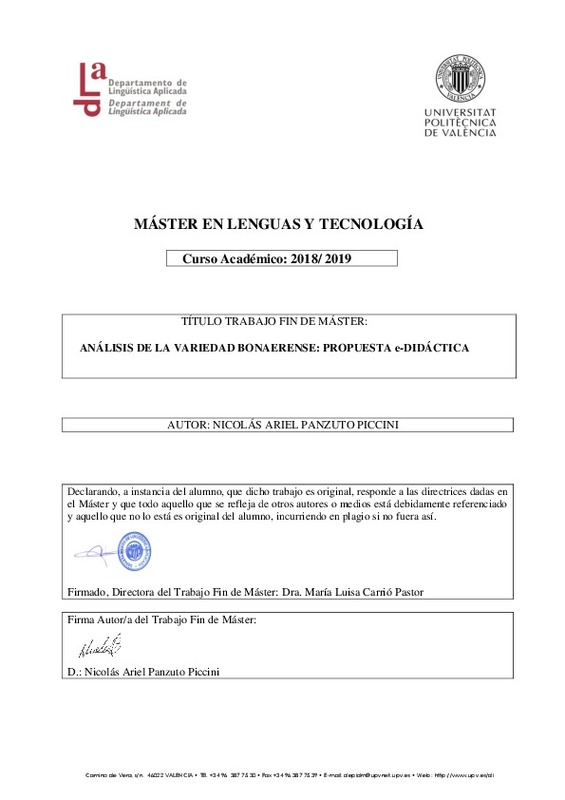JavaScript is disabled for your browser. Some features of this site may not work without it.
Buscar en RiuNet
Listar
Mi cuenta
Estadísticas
Ayuda RiuNet
Admin. UPV
Análisis del español bonaerense: propuesta e-didáctica
Mostrar el registro sencillo del ítem
Ficheros en el ítem
| dc.contributor.advisor | Carrió Pastor, Mª Luisa
|
es_ES |
| dc.contributor.author | Panzuto Piccini, Nicolás Ariel
|
es_ES |
| dc.coverage.spatial | east=-58.3947397368446; north=-34.38351885705284; name=Argentina | es_ES |
| dc.date.accessioned | 2019-11-08T08:26:27Z | |
| dc.date.available | 2019-11-08T08:26:27Z | |
| dc.date.created | 2019-09-30 | |
| dc.date.issued | 2019-11-08 | es_ES |
| dc.identifier.uri | http://hdl.handle.net/10251/130501 | |
| dc.description.abstract | [ES] El protagonismo del español como lengua extranjera es innegable y su presencia es patente en las aulas de aprendizaje de idiomas de todo el mundo. Con más de una veintena de países de habla hispana, crear un vínculo entre todas las variedades españolas representa un reto aparentemente imposible, especialmente considerando el evidente predominio del español peninsular en la academia. En cualquier caso, mucho ha sucedido desde entonces y hay una creciente demanda de establecer una variedad estándar común a todos los hispanohablantes sin ignorar la valiosa existencia de la gran cantidad de variedades diatópicas de esta lengua. Gracias al creciente número de estudios sobre estas variedades, podemos constatar que los estudiantes de español como lengua extranjera aprecian la variedad lingüística y a menudo muestran interés en aprenderlas. Las variedades argentinas de español, especialmente la variedad de Buenos Aires, no podía pasar desapercibida, probablemente por su alto número de hablantes y sus contribuciones culturales al mundo hispanoamericano. Prueba de ello es la presencia de esta variedad en los certificados españoles. Desafortunadamente, los estudiantes que quieren profundizar su conocimiento de las variedades argentinas se encuentran con un problema clave: la falta de recursos y materiales disponibles. Además, hay una escasa presencia de variedades diatópicas en los libros de texto de aprendizaje en español. Por todo ello, este trabajo pretende acercar a los estudiantes españoles a la variedad Buenos Aires. A partir de un resumen de las principales características de esta variedad y un análisis de los pocos recursos existentes, se buscará crear un primer punto de contacto con la variedad bonaerense para los estudiantes de español como lengua extranjera y potenciar su motivación para potenciar su experiencia de aprendizaje mediante el desarrollo de un recurso digital de autoaprendizaje. | es_ES |
| dc.description.abstract | [EN] The leading role of Spanish as a foreign language is undeniable and its presence is patent in language learning classrooms all over the world. With over a score of Spanish-speaking countries, creating a link between all Spanish varieties represents a challenge seemingly impossible, especially considering the evident predominance of peninsular Spanish in the academe. Perhaps this is because of the Spanish Empire booming and conquest, leading the use of its vernacular around the world. In any case, a lot has happened since then and there is a growing demand of for establishing a standard variety common to all Spanish-speaking people without ignoring the valuable existence of the vast amount of diatopical varieties of this language. Thanks to the increasing number of studies regarding these varieties, we can realize that students of Spanish as a foreign language appreciate linguistic variation and they often show interest in learning them too. Argentinean varieties of Spanish, especially the Buenos Aires variety, do not go unnoticed most probably because of its high number of speakers and its cultural contributions to the Spanish-American world. This is evidenced by the presence of this variety in Spanish certificates. Unfortunately, students who want to deepen their knowledge of Argentinean varieties encounter a key problem ¿the lack of resources and materials available. In addition, there is a scarce presence of diatopical varieties in Spanish learning textbooks. For all these reasons, this work aims to bring Spanish students closer to the Buenos Aires variety. Following a summary about the main features of this variety and an analysis of the -few- existing resources, we will seek to create a first point of contact with the Buenos Aires variety for students of Spanish as a foreign language and enhance their motivation to boost their learning experience by developing a self-learning digital resource. | es_ES |
| dc.language | Español | es_ES |
| dc.publisher | Universitat Politècnica de València | es_ES |
| dc.rights | Reserva de todos los derechos | es_ES |
| dc.subject | Español como lengua extranjera | es_ES |
| dc.subject | Español bonaerense | es_ES |
| dc.subject | Autoaprendizaje | es_ES |
| dc.subject | Propuesta e-didáctica | es_ES |
| dc.subject | Spanish as a foreign language | es_ES |
| dc.subject | Buenos Aires Spanish | es_ES |
| dc.subject | Self-learning | es_ES |
| dc.subject | E-learning | es_ES |
| dc.subject.classification | FILOLOGIA INGLESA | es_ES |
| dc.subject.other | Máster Universitario en Lenguas y Tecnología-Màster Universitari en Llengües i Tecnologia | es_ES |
| dc.title | Análisis del español bonaerense: propuesta e-didáctica | es_ES |
| dc.type | Tesis de máster | es_ES |
| dc.rights.accessRights | Abierto | es_ES |
| dc.contributor.affiliation | Universitat Politècnica de València. Departamento de Lingüística Aplicada - Departament de Lingüística Aplicada | es_ES |
| dc.description.bibliographicCitation | Panzuto Piccini, NA. (2019). Análisis del español bonaerense: propuesta e-didáctica. http://hdl.handle.net/10251/130501 | es_ES |
| dc.description.accrualMethod | TFGM | es_ES |
| dc.relation.pasarela | TFGM\117760 | es_ES |






